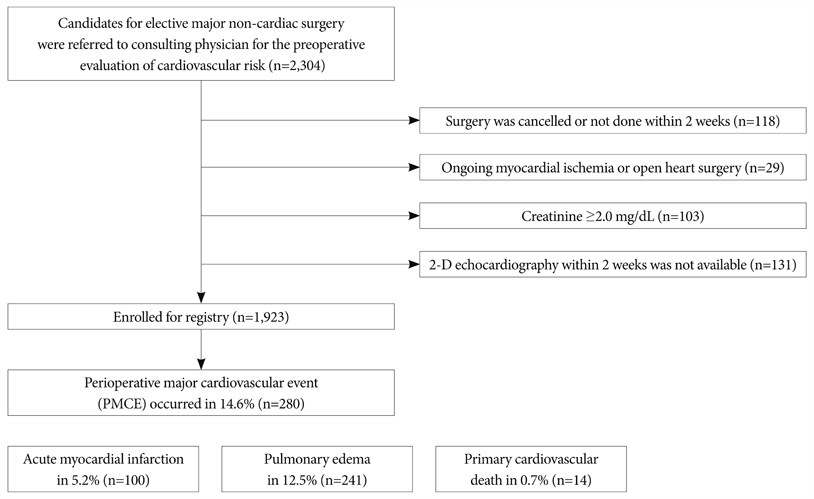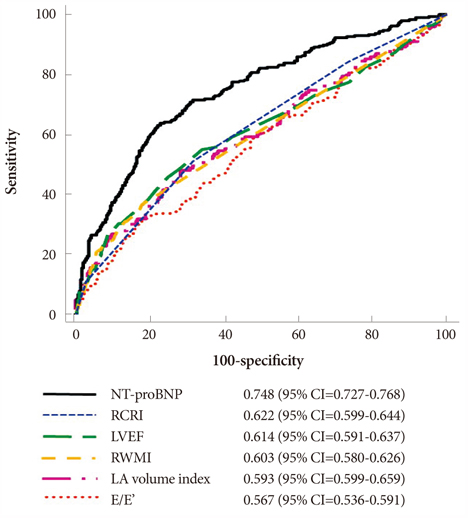Korean Circ J.
2011 Sep;41(9):505-511. 10.4070/kcj.2011.41.9.505.
Comparison of Transthoracic Echocardiography With N-Terminal Pro-Brain Natriuretic Peptide as a Tool for Risk Stratification of Patients Undergoing Major Noncardiac Surgery
- Affiliations
-
- 1Department of Medicine, Cardiovascular Imaging Center, Cardiac and Vascular Center, Samsung Medical Center, Sungkyunkwan University School of Medicine, Seoul, Korea. choijinh@gmail.com
- 2Department of Emergency Medicine, Cardiovascular Imaging Center, Cardiac and Vascular Center, Samsung Medical Center, Sungkyunkwan University School of Medicine, Seoul, Korea.
- 3Division of Cardiovascular Diseases, Mayo Clinic College of Medicine, Rochester, Minnesota, USA.
- KMID: 2094102
- DOI: http://doi.org/10.4070/kcj.2011.41.9.505
Abstract
- BACKGROUND AND OBJECTIVES
The role of preoperative transthoracic echocardiography (TTE) for the risk stratification has not been well investigated yet. We compared the predictive power of TTE with N-terminal pro-brain natriuretic peptide (NT-proBNP), a representative biomarker that predicts perioperative cardiovascular risk, and investigated whether these tests have incremental value to the clinically determined risk.
SUBJECTS AND METHODS
We evaluated the Revised Cardiac Risk Index (RCRI), TTE, and NT-proBNP in 1,923 noncardiac surgery cases. The primary endpoint was a perioperative major cardiovascular event (PMCE), which was defined by any single or combined event of secondary endpoints including myocardial infarction, development of pulmonary edema, or primary cardiovascular death within 30 days after surgery.
RESULTS
All echocardiographic parameters including left ventricular ejection fraction, regional wall motion score index, and transmitral early diastolic velocity/tissue Doppler mitral annular early diastolic velocity (E/E') were predictive of PMCE (c-statistics=0.579+/-0.019 to 0.589+/-0.015), but none of these parameters were better than the clinically determined RCRI (c-statistics=0.594+/-0.019) and were inferior to NT-proBNP (c-statistics=0.748+/-0.019, p<0.001). The predictive power of RCRI {adjusted relative risk (RR)=1.4} could be improved by addition of echocardiographic parameters (adjusted RR=1.8, p<0.001), but not to that extent as by addition of NT-proBNP to RCRI (adjusted RR=3.7, p<0.001).
CONCLUSION
TTE was modestly predictive of perioperative cardiovascular events but was not superior to NT-proBNP. Moreover, it did not have incremental value to the clinically determined risk. The results of our study did not support the use of routine echocardiography before noncardiac surgery.
MeSH Terms
Figure
Reference
-
1. Fleisher LA, Beckman JA, Brown KA, et al. 2009 ACCF/AHA focused update on perioperative beta blockade incorporated into the ACC/AHA 2007 guidelines on perioperative cardiovascular evaluation and care for noncardiac surgery. J Am Coll Cardiol. 2009. 54:e13–e118.2. Halm EA, Browner WS, Tubau JF, Tateo IM, Mangano DT. Echocardiography for assessing cardiac risk in patients having noncardiac surgery. Study of Perioperative Ischemia Research Group. Ann Intern Med. 1996. 125:433–441.3. Rohde LE, Polanczyk CA, Goldman L, Cook EF, Lee RT, Lee TH. Usefulness of transthoracic echocardiography as a tool for risk stratification of patients undergoing major noncardiac surgery. Am J Cardiol. 2001. 87:505–509.4. Kertai MD, Poldermans D, Bax JJ, Klein J, Van Urk H. Cardiac risk and perioperative management. J Cardiovasc Surg (Torino). 2003. 44:431–435.5. Choi JH, Cho DK, Song YB, et al. Preoperative NT-proBNP and CRP predict perioperative major cardiovascular events in non-cardiac surgery. Heart. 2010. 96:56–62.6. Feringa HH, Bax JJ, Elhendy A, et al. Association of plasma N-terminal pro-B-type natriuretic peptide with postoperative cardiac events in patients undergoing surgery for abdominal aortic aneurysm or leg by-pass. Am J Cardiol. 2006. 98:111–115.7. Yun KH, Jeong MH, Oh SK, et al. Preoperative plasma N-terminal pro-brain natriuretic peptide concentration and perioperative cardio-vascular risk in elderly patients. Circ J. 2008. 72:195–199.8. Karthikeyan G, Moncur RA, Levine O, et al. Is a pre-operative brain natriuretic peptide or N-terminal pro-B-type natriuretic peptide measurement an independent predictor of adverse cardiovascular outcomes within 30 days of noncardiac surgery? A systematic review and meta-analysis of observational studies. J Am Coll Cardiol. 2009. 54:1599–1606.9. Lee TH, Marcantonio ER, Mangione CM, et al. Derivation and prospective validation of a simple index for prediction of cardiac risk of major noncardiac surgery. Circulation. 1999. 100:1043–1049.10. Devereaux PJ, Goldman L, Cook DJ, Gilbert K, Leslie K, Guyatt GH. Perioperative cardiac events in patients undergoing noncardiac surgery: a review of the magnitude of the problem, the pathophysiology of the events and methods to estimate and communicate risk. CMAJ. 2005. 173:627–634.11. Lang RM, Bierig M, Devereux RB, et al. Recommendations for chamber quantification: a report from the American Society of Echocardiography's Guidelines and Standards Committee and the Chamber Quantification Writing Group, developed in conjunction with the European Association of Echocardiography, a branch of the European Society of Cardiology. J Am Soc Echocardiogr. 2005. 18:1440–1463.12. Stephan C, Wesseling S, Schink T, Jung K. Comparison of eight computer programs for receiver-operating characteristic analysis. Clin Chem. 2003. 49:433–439.13. Zhang J, Yu KF. What's the relative risk? A method of correcting the odds ratio in cohort studies of common outcomes. JAMA. 1998. 280:1690–1691.14. Kontos MC, Brath LK, Akosah KO, Mohanty PK. Cardiac complications in noncardiac surgery: relative value of resting two-dimensional echocardiography and dipyridamole thallium imaging. Am Heart J. 1996. 132:559–566.15. Takase B, Younis LT, Byers SL, et al. Comparative prognostic value of clinical risk indexes, resting two-dimensional echocardiography, and dipyridamole stress thallium-201 myocardial imaging for perioperative cardiac events in major nonvascular surgery patients. Am Heart J. 1993. 126:1099–1106.16. Struthers A, Lang C. The potential to improve primary prevention in the future by using BNP/N-BNP as an indicator of silent 'pancardiac' target organ damage: BNP/N-BNP could become for the heart what microalbuminuria is for the kidney. Eur Heart J. 2007. 28:1678–1682.17. Poldermans D, Hoeks SE, Feringa HH. Pre-operative risk assessment and risk reduction before surgery. J Am Coll Cardiol. 2008. 51:1913–1924.18. Schouten O, Bax JJ, Poldermans D. Preoperative cardiac risk assessment in vascular surgery patients: seeing beyond the perioperative period. Eur Heart J. 2008. 29:283–284.19. Dokainish H, Zoghbi WA, Lakkis NM, Quinones MA, Nagueh SF. Comparative accuracy of B-type natriuretic peptide and tissue Doppler echocardiography in the diagnosis of congestive heart failure. Am J Cardiol. 2004. 93:1130–1135.
- Full Text Links
- Actions
-
Cited
- CITED
-
- Close
- Share
- Similar articles
-
- Clinical Implication of B-type Natriuretic Peptide in the Elderly
- Biomarkers in Heart Failure: Focus on B-type Natriuretic Peptide
- Changes in N-terminal pro-B-type natriuretic peptide in a neonate with symptomatic isolated left ventricular noncompaction
- Correlation between N-Terminal Pro-Brain Natriuretic Peptide and Doppler Echocardiographic Parameters of Left Ventricular Filling Pressure in Atrial Fibrillation
- Role of Brain Natriuretic Peptide as a Prognostic Marker in Non-Cardiac Surgery



